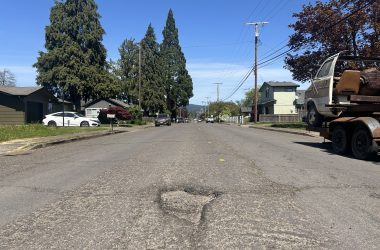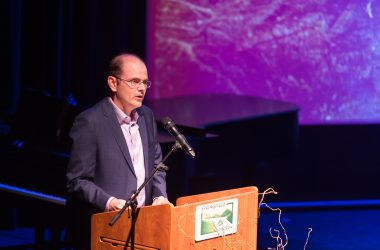Maybe they are the antidote to the “McMansion” craze of Western living, or a Hail Mary attempt to put a roof over more people’s heads, but the idea of tiny homes is one that seems like it’s here to stay.
After all, the movement is trying to solve one of our region’s biggest problems: lack of affordable housing and overall homelessness. Oregon is short at least 110,000 housing units, according to a 2022 analysis.
There is a growing movement to try to cut into that massive shortfall, and though described as tiny, it’s also mighty — the tiny home movement.
Depending on the chosen definition, a tiny home is less than 400 square feet, and variations of it can even be as small as 60 square feet. And a tiny home can serve different needs. For some, a tiny home is a permanent residence for people who’ve downsized their life and downsized their spending. For others, a tiny home is a temporary clean and safe shelter from homelessness.
While agreeing that tiny homes alone won’t solve homelessness nor the housing crisis in our community, they cannot be overlooked as a big part of the overall solution.
According to Annie Loe, an Urban Design Planner with the City of Eugene, the tiny home movement is part of a larger effort to squeeze out as many dwellings as possible with the land and space we already have.
“The legislation passed in 2017 (Senate Bill 1051) created a real opportunity to build more units on existing space,” she said. “The units, called accessory dwelling units (ADUs), are a good use of out-of-the-box thinking to help solve our housing shortage crisis.”
ADUs can be anything from a spare room in an existing house, to a converted garage – to an entire village of tiny homes like the ones we might see at places like the Cottage Village in Cottage Grove and the C Street Co-Op in Springfield.
“Tiny homes are a good answer to sprawling developments that cost a tremendous amount of money and resources,” said Loe. “Anyone with property can add or build an ADU including tiny homes.”
One person who is a great believer in the tiny home village concept is Dan Bryant, the executive director of Square One Villages, which has created many tiny home villages in the community.
“Tiny Homes are less expensive. They use less energy and create a true sense of community,” Bryant said. “We don’t just build tiny structure – we build villages. And the village concept exploits the concept of economies of scale. We can build denser and cheaper while creating a true community.”
Square One is a nonprofit that manages more than seven separate villages. Some are basic structures to provide shelter for those who experience homelessness, while others are full homes that provide lower-income people the opportunity to become homeowners.
The funding model is often driven by donors and philanthropists who believe in the concept. However, the state has kicked in important funding recently, including $6 million for Square One’s Peace Village in Eugene, which uses an existing church property for the land.
Speaking of church property, Community Supported Shelters of Lane County has utilized private property and church parking lots to amass an impressive number of Conestoga huts to house formerly houseless individuals.
These huts of around 60 square feet provide stability for many people who have no other alternative and help get many people back on their feet with shelter and security.

According to Heather Quaas-Annsa, the executive director of the organization, they kind of operate in a perfect gray space for people experiencing homelessness.
“We provide alternative shelter – not emergency shelter, nor permanent shelter, but in-between,” she said. “And because the Conestoga Huts are actually classified as vehicles, it’s a lot easier to find space for them.”
Quaas-Annsa also points out that the experience of managing nearly 150 units has shown that these villages actually improve an area once the units go up.
“Indeed, many people thought these villages would become full of crime and drugs and trash, but that’s not the case,” she said. “In fact, most neighbors that we keep in contact with during and after the citing process tell us that the neighborhood got better from us being there.”
For Paul Miller, a former resident of Square One’s Opportunity Village, which provides space for those experiencing homelessness in Eugene, it was his life and his outlook that got decidedly better.
“For much of my adult life, I had drug problems and social problems and I had run out of couch surfing opportunities,” he said. “Nearing a critical point, someone recommended this idea of Opportunity Village and I decided to apply.”
He hasn’t looked back.
“Reality shifted for me. Opportunity Village offered me security and the dignity of a closed door and key,” he said. “Those little things mean so much, and it added up to a turning point in my life.”
Today, Miller is a homeowner, and he spends a good deal of his time talking about his story and how a tiny home village can help others as well.
Annie Loe said that tiny homes are not the one-stop solution to homelessness and our housing crisis, but rather a part of the overall mosaic of solutions. But the facts are indisputable:
• They are easier to find a site than the other types of shelters.
• They cost a lot less.
• They are more energy efficient.
• They fit nicely in the state’s ADU ordinance.
• They can create a community where there was once just hopelessness.
So, next time you drive by these tiny home villages or grouping of Conestoga Huts, you might just be passing by a key part of ending our state and region’s housing crisis.
Michael Dunne is a business and economic columnist for The Chronicle.








